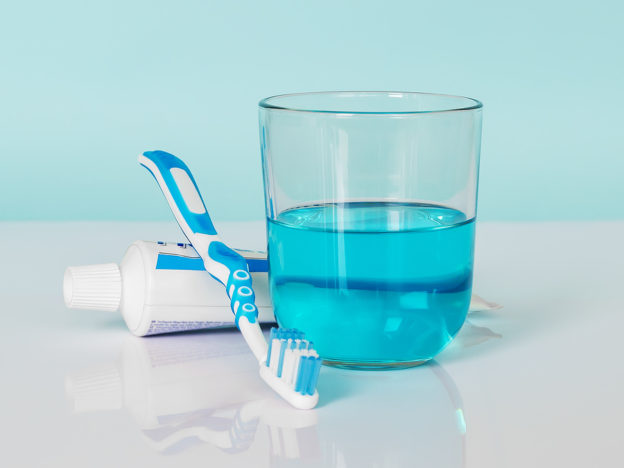By David Blyweiss, M.D., Advanced Natural Wellness
May 22, 2020
Recently, I started using a water pick to clean my teeth after breakfast and dinner. Standing with my mouth wide open over the sink, I’ll shoot a steady stream of water over and between my pearly whites, front and back.
You know what? The amount of food particles that land in my sink is unbelievable. And that’s after brushing!
So, what’s your dental routine like?
For many of us, it looks like this… brush, floss, swish, spit. You do it every morning and every evening. Maybe even after one or more of your meals.
But is it good for you?
It all depends.
If you use mainstream toothpaste several times a day, you are likely exposing yourself to numerous toxic ingredients. Some of these chemicals include…
Fluoride is a known neurotoxin that is also linked with underactive thyroid. Additionally, fluoride may contribute to the development of Alzheimer’s disease. Over time, too much fluoride may cause dental fluorosis – white streaks on your teeth that can turn into brown stains.
Formaldehyde – a known human carcinogen – is sometimes used as a preservative in toothpaste. Exposure to it is linked to the development of several different types of cancer.
MD Exposes the Hidden Danger to Your Eyes

When your eyesight starts to fail, it's a real problem. Suddenly you can't go to the grocery store... you can't get to the doctor if you have an emergency... you can't meet your friends for dinner…
Your "regular" doctor doesn't have time to keep up with the latest research. And the same goes for eye doctors. They go to school to learn how to fit you for glasses and contacts, but have no way of preventing the damage and loss of eyesight that threatens your freedom and independence.
Let me show you something that explains a LOT about how your eyes work.
In my FREE Special Report, I'll show you a HUGE, untapped resource for your eyes that safely and naturally restores clear, effortless eyesight.
Click here to get started...
Triclosan is an antibacterial that can still be found in some brands of toothpaste… even though it was banned for use in liquid hand and body soaps a couple of years ago. Why was it banned? Because it wasn’t recognized by the FDA as a safe ingredient. And for good reason! It disrupts the endocrine system, suppresses thyroid function and promotes liver disease.
Polyethylene Glycol (PEG) helps keep your toothpaste from drying out. At the same time, it increases the absorption of other dangerous ingredients into your bloodstream.
Not only that, but the tissue and membranes in your mouth are already extremely effective when it comes to absorbing chemicals. That’s why heart patients place their nitroglycerin pills under their tongues… for faster delivery.
Plus, even though you spit your toothpaste it out after brushing, chances are good you’re swallowing a little bit. So every time you brush you are getting a small but dangerous dose of the toxic substances in your toothpaste.
I find this to be a problem… but an even bigger threat may actually come from your mouthwash.
What is Your Mouthwash Doing to Your Health?
The general consensus for mouthwashes is that they kill the germs that cause bad breath. And it’s true. Mouth rinses are great at killing bacteria in your mouth.
But this is exactly where the problem lies.
You see, your oral bacteria produces nitrate which, in turn, stimulates the production of nitric oxide (NO) in your body. This is a compound that helps your blood vessels relax and expand, allowing blood to flow freely throughout your body.
Now here’s the thing.
Higher nitric oxide levels are associated with lower blood pressure, reduced arterial stiffness and less chance of plaque build-up. But when you wipe out all of the bacteria in your mouth, you’re losing the nitric oxide factory hiding in your oral cavity.
Guess what happens next?
Using antiseptic mouthwash for as little as a week decreases oral nitrite production by about 90% and results in measurably lower blood levels of nitric oxide.
Are You Suffering From...
- Love handles and a pot belly
- Romance that isn't what it used to
- Forgetfulness and inattention
- Low (or no) strength and endurance
- A sex drive that's shifted into neutral...or worse
If so...you may have Mature Male Burnout. Click here to discover more about this unique condition and what you can do about it.
This can cause a jump in systolic and diastolic blood pressure by 2 to 3.5 mm Hg. And these higher blood pressure readings can start as early as the first day of mouthwash use.
The effect is so pronounced that if you rinse prior to exercise, you actually lose the nitric oxide boost that physical activity normally provides. It lowers the blood-pressure-lowering effect of exercise by 60% in the first hour… and completely after two hours.
To make matters even worse, people who use over-the-counter mouthwash twice a day are 55% more likely to develop diabetes or pre-diabetes compared to people who swish only once daily.
This, again, is due to the effect mouth rinses have on nitrate-generating oral bacteria and nitric oxide levels.
To avoid all of these hazards when you brush, floss, swish and rinse, here is what I recommend:
Brush daily twice daily with a safe, natural, non-toxic toothpaste. Or try making your own. It’s super easy. Just use equal parts baking soda and coconut oil – say 4 tablespoons each – and add 15 or 20 drops of essential oil like cinnamon, spearmint or peppermint. Then, blend and brush.
Floss right after brushing to remove any hidden debris. Never floss before you brush or you’ll end up pushing bacteria down into your gums. I’ve had episodes where this happened and my gums became inflamed and infected.
Water pick. If you have a water pick, use that right after flossing to remove any remaining debris.
Rinse with a mouthwash that’s fluoride, alcohol and saccharin free. Better yet, try finding a good all-natural mouthwash to replace it with. You can even make your own at home. All you have to do is mix a cup of distilled water with a teaspoon of baking soda and a few drops of peppermint oil.
I also like the idea of taking an oral probiotic. They are similar to mints. But don’t chew them! Just roll the pill or lozenge around in your mouth until it dissolves on its own.
If I don’t have any of these oral probiotics, I’ll just swish around the kombucha that I have every night with dinner. Swish it around in your mouth before swallowing.
SOURCES:
Valdez-Jiménez L, et al. Effects of the fluoride on the central nervous System. Neurologia. 2011 Jun;26(5):297-300.
Peckham S, et al. Are fluoride levels in drinking water associated with hypothyroidism prevalence in England? A large observational study of GP practice data and fluoride levels in drinking water. J Epidemiol Community Health. 2015 Jul;69(7):619-24.
Mahlberg R, et al. Pineal calcification in Alzheimer’s disease: an in vivo study using computed tomography. Neurobiol Aging. 2008 Feb;29(2):203-9.
Luke J. Fluoride deposition in the aged human pineal gland. Caries Res. 2001 Mar-Apr;35(2):125-8.
Behind the Dazzling Smile. Cornucopia Institute. July 2016.
Report on Carcinogens, Fourteenth Edition: Formaldehyde. National Toxicology Program. Department of Health and Human Services. Nov 2016.
Stoker TE, et al. Triclosan exposure modulates estrogen-dependent responses in the female wistar rat. Toxicol Sci. 2010 Sep;117(1):45-53.
Cherednichenko G, et al. Triclosan impairs excitation-contraction coupling and Ca2+ dynamics in striated muscle. Proc Natl Acad Sci U S A 2012 Aug 13;109(35):14158-63.
Yueh MF, et al. The commonly used antimicrobial additive triclosan is a liver tumor promoter. Proc Natl Acad Sci U S A. 2014 Dec 2;111(48):17200-5.
Kapil V, et al. Physiological role for nitrate-reducing oral bacteria in blood pressure control. Free Radic Biol Med. 2013 Feb; 55: 93–100.
Cutler C, et al. Post-exercise hypotension and skeletal muscle oxygenation is regulated by nitrate-reducing activity of oral bacteria. Free Radical Biology and Medicine, 2019; 143: 252.
Joshipura KJ, et al. Over-the-counter mouthwash use and risk of pre-diabetes/diabetes. Nitric Oxide. 2017 Dec;71(1):14-20
Haukioja, Anna. “Probiotics and oral health.” European journal of dentistry vol. 4,3 (2010): 348-55. https://www.ncbi.nlm.nih.gov/pmc/articles/PMC2897872/







